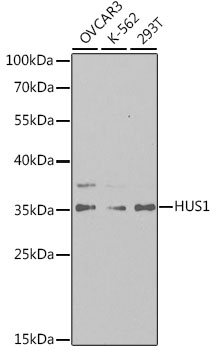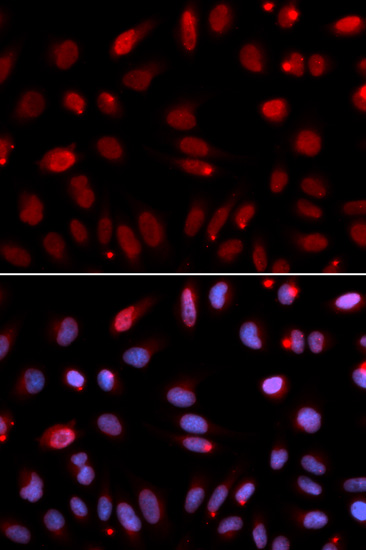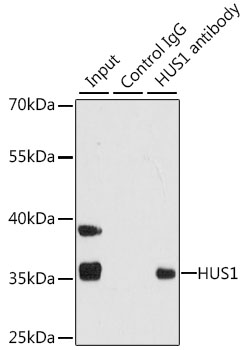Epigenetics & Nuclear Signaling Antibodies 3
Anti-HUS1 Antibody (CAB5407)
- SKU:
- CAB5407
- Product Type:
- Antibody
- Reactivity:
- Human
- Reactivity:
- Mouse
- Host Species:
- Rabbit
- Isotype:
- IgG
- Antibody Type:
- Polyclonal Antibody
- Research Area:
- Epigenetics and Nuclear Signaling
Description
| Antibody Name: | Anti-HUS1 Antibody |
| Antibody SKU: | CAB5407 |
| Antibody Size: | 20uL, 50uL, 100uL |
| Application: | WB IF IP |
| Reactivity: | Human, Mouse |
| Host Species: | Rabbit |
| Immunogen: | Recombinant fusion protein containing a sequence corresponding to amino acids 1-280 of human HUS1 (NP_004498.1). |
| Application: | WB IF IP |
| Recommended Dilution: | WB 1:500 - 1:2000 IF 1:50 - 1:100 IP 1:50 - 1:200 |
| Reactivity: | Human, Mouse |
| Positive Samples: | OVCAR-3, K-562, 293T |
| Immunogen: | Recombinant fusion protein containing a sequence corresponding to amino acids 1-280 of human HUS1 (NP_004498.1). |
| Purification Method: | Affinity purification |
| Storage Buffer: | Store at -20'C. Avoid freeze / thaw cycles. Buffer: PBS with 0.02% sodium azide, 50% glycerol, pH7.3. |
| Isotype: | IgG |
| Sequence: | MKFR AKIV DGAC LNHF TRIS NMIA KLAK TCTL RISP DKLN FILC DKLA NGGV SMWC ELEQ ENFF NEFQ MEGV SAEN NEIY LELT SENL SRAL KTAQ NARA LKIK LTNK HFPC LTVS VELL SMSS SSRI VTHD IPIK VIPR KLWK DLQE PVVP DPDV SIYL PVLK TMKS VVEK MKNI SNHL VIEA NLDG ELNL KIET ELVC VTTH FKDL GNPP LASE STHE DRNV EHMA EVHI DIRK LLQF LAGQ QVNP TKAL CNIV NNKM VHFD LLHE DVSL QYFI PALS |
| Gene ID: | 3364 |
| Uniprot: | O60921 |
| Cellular Location: | Cytoplasm, Nucleus |
| Calculated MW: | 29kDa/31kDa |
| Observed MW: | 35kDa |
| Synonyms: | HUS1, hHUS1 |
| Background: | The protein encoded by this gene is a component of an evolutionarily conserved, genotoxin-activated checkpoint complex that is involved in the cell cycle arrest in response to DNA damage. This protein forms a heterotrimeric complex with checkpoint proteins RAD9 and RAD1. In response to DNA damage, the trimeric complex interacts with another protein complex consisting of checkpoint protein RAD17 and four small subunits of the replication factor C (RFC), which loads the combined complex onto the chromatin. The DNA damage induced chromatin binding has been shown to depend on the activation of the checkpoint kinase ATM, and is thought to be an early checkpoint signaling event. Alternative splicing results in multiple transcript variants. |
| UniProt Protein Function: | HUS1: Component of the 9-1-1 cell-cycle checkpoint response complex that plays a major role in DNA repair. The 9-1-1 complex is recruited to DNA lesion upon damage by the RAD17-replication factor C (RFC) clamp loader complex. Acts then as a sliding clamp platform on DNA for several proteins involved in long-patch base excision repair (LP-BER). The 9-1-1 complex stimulates DNA polymerase beta (POLB) activity by increasing its affinity for the 3'-OH end of the primer-template and stabilizes POLB to those sites where LP-BER proceeds; endonuclease FEN1 cleavage activity on substrates with double, nick, or gap flaps of distinct sequences and lengths; and DNA ligase I (LIG1) on long-patch base excision repair substrates. The 9-1-1 complex is necessary for the recruitment of RHNO1 to sites of double-stranded breaks (DSB) occurring during the S phase. Belongs to the HUS1 family. |
| UniProt Protein Details: | Protein type:DNA repair, damage; Cell cycle regulation Chromosomal Location of Human Ortholog: 7p13-p12 Cellular Component: nucleoplasm; cytoplasm; nucleolus; nucleus Molecular Function:protein binding Biological Process: regulation of protein amino acid phosphorylation; embryonic development; negative regulation of DNA replication; mitotic cell cycle checkpoint; DNA damage checkpoint; DNA repair; DNA replication; response to DNA damage stimulus; protein amino acid phosphorylation; double-strand break repair via homologous recombination; response to UV |
| NCBI Summary: | The protein encoded by this gene is a component of an evolutionarily conserved, genotoxin-activated checkpoint complex that is involved in the cell cycle arrest in response to DNA damage. This protein forms a heterotrimeric complex with checkpoint proteins RAD9 and RAD1. In response to DNA damage, the trimeric complex interacts with another protein complex consisting of checkpoint protein RAD17 and four small subunits of the replication factor C (RFC), which loads the combined complex onto the chromatin. The DNA damage induced chromatin binding has been shown to depend on the activation of the checkpoint kinase ATM, and is thought to be an early checkpoint signaling event. Alternative splicing results in multiple transcript variants. [provided by RefSeq, Feb 2011] |
| UniProt Code: | O60921 |
| NCBI GenInfo Identifier: | 74735462 |
| NCBI Gene ID: | 3364 |
| NCBI Accession: | O60921.1 |
| UniProt Secondary Accession: | O60921,B4DFI9, |
| UniProt Related Accession: | O60921 |
| Molecular Weight: | 280 |
| NCBI Full Name: | Checkpoint protein HUS1 |
| NCBI Synonym Full Names: | HUS1 checkpoint homolog (S. pombe) |
| NCBI Official Symbol: | HUS1 |
| NCBI Official Synonym Symbols: | hHUS1 |
| NCBI Protein Information: | checkpoint protein HUS1; hus1+-like protein |
| UniProt Protein Name: | Checkpoint protein HUS1 |
| Protein Family: | Checkpoint protein |
| UniProt Gene Name: | HUS1 |
| UniProt Entry Name: | HUS1_HUMAN |
View AllClose










